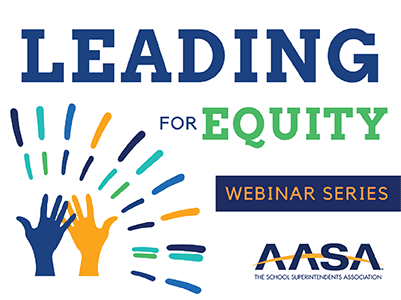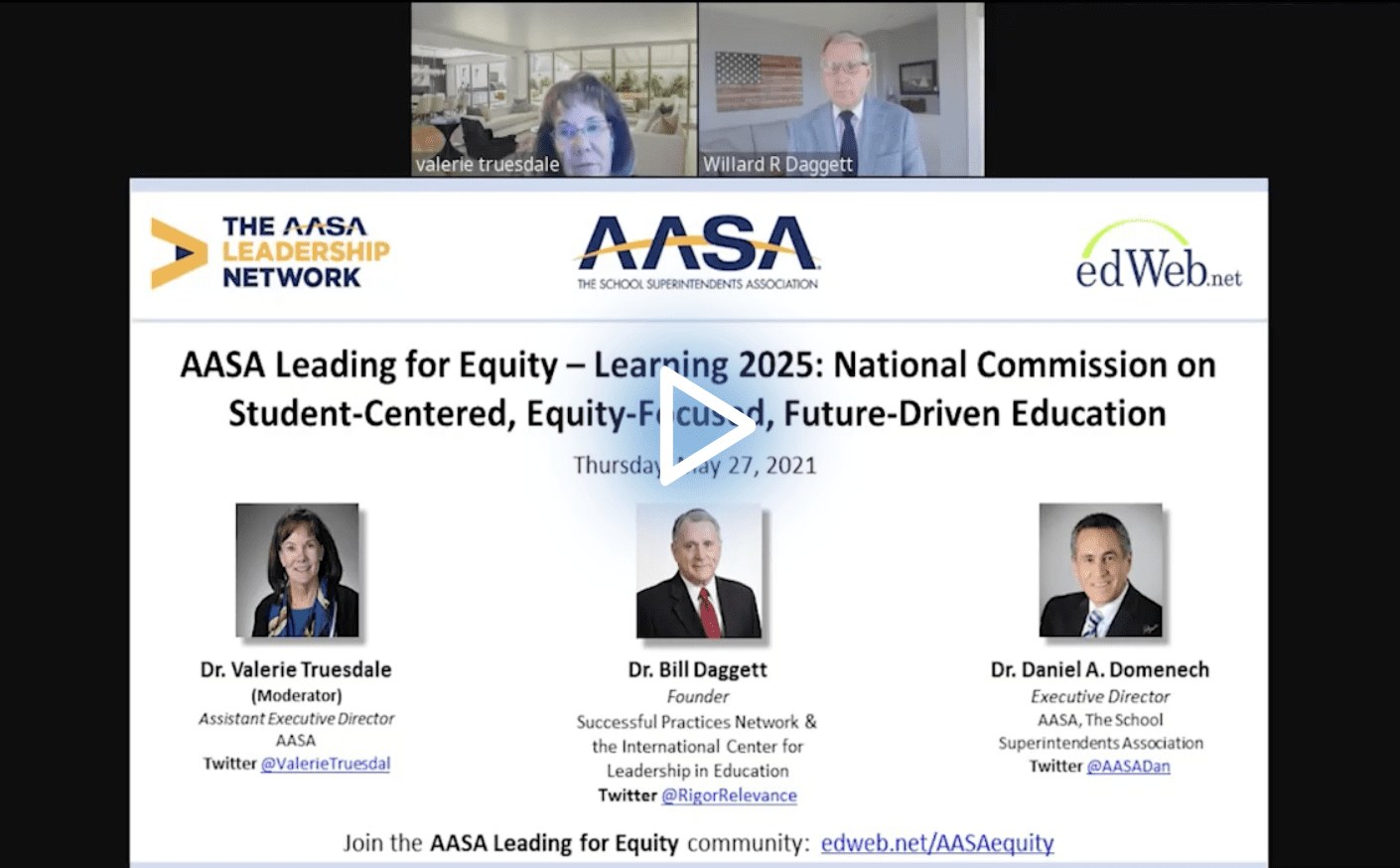Redesigning, Reimagining, and Rethinking American Education
Education is just different than it was pre-pandemic—many school leaders think it shouldn’t go back to the way it was before when schools used systems developed in the 20th century. But that doesn’t mean even more changes aren’t needed. In a recent edWebinar, hosted by AASA, The School Superintendents Association and AASA’s Leadership Network, the presenters discussed the findings of the AASA Learning 2025 National Commission and the need to get more students engaged in their own educational experience.
The AASA Learning 2025 National Commission was created to develop recommendations on transforming education to be more student-centered, equity-focused and forward-reaching. The outcome of this commission is Learning 2025: Student-Centered, Equity-Focused Education, an AASA initiative that calls for holistic redesign of the public school system by 2025. Currently, AASA is looking for demonstration districts to implement their recommendations and transform education.
Key Challenges Identified by the Commission
- How to fully engage students: The current and next generation of learners have never lived without smartphones, the internet, etc. These tools have become extensions of their body. Instead of discouraging them from using these devices, though, schools should embrace their growing capabilities.
- Growing achievement gaps: Research shows not only did student learning gains slow down during the pandemic, but for students of color, the gains were even less. In order to improve U.S. education, no child should be marginalized because of their race, religion, gender, socioeconomic status, disability, etc.
- Rising need for social-emotional learning (SEL): Research shows as terrible as the growing achievement gap is, so is the rise in mental health issues among young people. Students need their schools to help them build SEL skills to prepare them for life outside the classroom.
- Preparing students for success: Additional research says students need technological, SEL, higher cognitive, basic cognitive, and manual and physical skills to succeed in the workforce. And while many schools are not teaching this range of skills, teachers are already stretched to the limit and can’t take on any more challenges. Thus, schools need to figure out how to use resources more effectively and what they’re currently doing that they could remove from the curriculum.
- Integrating tech advancements: The pandemic has shown workers can succeed when the work comes to them, but how would that work in schools? Education leaders need to figure out what the new classroom dynamic looks like, if there even is a classroom, and how technology could help them reach more students.
Three Essential Recommendations
- Help students co-author their learning journey: Shift from students receiving instruction at a predetermined date and time to letting students show their mastery through a personalized journey.
- Reengineer the learning journey: Shift from a series of disconnected classes to a coordinated set of experiences.
- Redesign the system: Take a look at budgeting, staffing, physical planning, etc. Every aspect of the school should support student-centered learning.
The Commission believes schools will need at least four years to effect change. Even then, they’ll need to continually measure what they’re doing against what students need for future success. The goal is to never again try to make students from the next generation fit into the box of an education system from 100 years ago.
This edWeb broadcast was hosted by AASA, The School Superintendents Association and AASA’s Leadership Network, providing premier professional learning for educational leaders.
Watch the Recording Listen to the Podcast
About the Presenters
Bill Daggett, Ed.D. is the founder of both the Successful Practices Network and the International Center for Leadership in Education. He is recognized worldwide for his proven ability to move preK-12 education systems towards more rigorous and relevant skills and knowledge for all students. For 30 years, he has crisscrossed our nation, as well as the industrialized world, to lead school reform efforts to effectively prepare students for their future.
While an avid supporter of public education, he also challenges all of us to be more focused on our children’s future than on maintaining the schools of our youth. His insights and leadership have caused nearly every major education association in the country, hundreds of school districts, numerous political and business leaders, publishers, and others to seek out his advice and guidance.
Dr. Daggett began his career as a teacher, local administrator, and then director with the New York State Education Department. He spends much of his time providing leadership and guidance to the National Dropout Prevention Center and the Career and Technical Education Technical Assistance Center, which are part of the Successful Practices Network.
He is the creator of the Rigor/Relevance Framework which has recently become the cornerstone of much of the nation’s school reform efforts. He is also the author of numerous books about learning and education, textbooks, research reports, and journal articles.
Dr. Daggett has been recognized as a distinguished alumnus by both Temple University and the State University at Albany.
Dr. Daggett has a special commitment to individuals with disabilities. He and his wife, Bonnie, volunteer their time and lend their support to Wildwood Programs in upstate New York. Wildwood serves the needs of people of all ages who, like their daughter Audrey, have neurological impairments/learning disabilities or autism, by enabling them to become the best that they can be.
Dr. Daniel A. Domenech has served as Executive Director of AASA, The School Superintendents Association since July 2008. Dr. Domenech has more than 36 years of experience in public education, 27 of those years served as a school superintendent.
Prior to joining AASA, Dr. Domenech served as Senior Vice President for National Urban Markets with McGraw-Hill Education. In this role, he was responsible for building strong relationships with large school districts nationwide.
Prior to his position at McGraw-Hill, Dr. Domenech served for seven years as Superintendent of the Fairfax County Public Schools (VA), the 12th largest school system in the nation with 168,000 students.
Dr. Domenech, an AASA member since 1979, served as President of AASA from July 1998 to June 1999. He is also a past president of the New York State Council of School Superintendents, the Suffolk County Superintendents Association, and the Suffolk County Organization for Promotion of Education. He was the first president and co-founder of the New York State Association for Bilingual Education.
In addition, Dr. Domenech has served on the U.S. Department of Education’s National Assessment Governing Board, the advisory board for the Department of Defense Schools, the board of directors of the Association for the Advancement of International Education, the Board of Overseers for the Baldrige Award and the boards of the Institute for Educational Leadership, National Board for Professional Teaching Standards, Sea Research Foundation, and Education Policy Institute. Currently, he serves on the boards of the Learning First Alliance, National Student Clearinghouse, Center for Naval Analyses, Horace Mann Educators Corporation, ACT, and USAC, and as Board Chair for Communities in Schools of Virginia.
About the Moderator
Dr. Valerie Truesdale joined AASA early in 2019 as the assistant executive director responsible for guiding leadership development services and programs. With years of experience in the superintendency and roles in instructional technology, she knows that AASA’s Leadership Network can be a substantial resource for school leaders trying to keep pace with the rapidly changing delivery of K-12 education.
Join the Community
Leading for Equity is a free professional learning community on edWeb.net for school and district leaders who face many challenges leading schools and driving school improvement for all students, especially now with COVID-19.
The AASA Leadership Network drives superintendent success, innovation, and growth, shaping the future of public education while preparing students for what’s next. We are the largest, most diverse network of superintendents in America. Passionate and committed, we connect educational leaders to the professional learning, leadership development, relationships, and partnerships they need to ensure a long career of impact.
The summary of this presentation was written by Stacey Pusey.
Stacey Pusey is an education communications consultant and writer. She assists education organizations with content strategy and teaches writing at the college level. Stacey has worked in the preK-12 education world for 20 years, spending time on school management and working for education associations including the AAP PreK-12 Learning Group. Stacey is working with edWeb.net as a marketing communications advisor and writer.






Comments are closed.